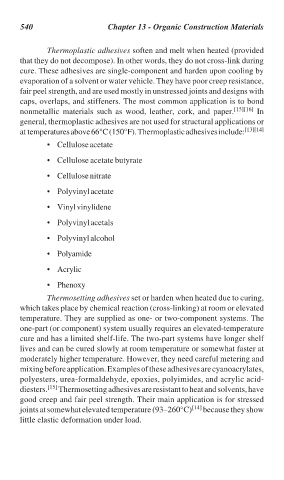Page 570 - Handbook of Thermal Analysis of Construction Materials
P. 570
540 Chapter 13 - Organic Construction Materials
Thermoplastic adhesives soften and melt when heated (provided
that they do not decompose). In other words, they do not cross-link during
cure. These adhesives are single-component and harden upon cooling by
evaporation of a solvent or water vehicle. They have poor creep resistance,
fair peel strength, and are used mostly in unstressed joints and designs with
caps, overlaps, and stiffeners. The most common application is to bond
nonmetallic materials such as wood, leather, cork, and paper. [15][16] In
general, thermoplastic adhesives are not used for structural applications or
at temperatures above 66°C (150°F). Thermoplastic adhesives include: [13][14]
• Cellulose acetate
• Cellulose acetate butyrate
• Cellulose nitrate
• Polyvinyl acetate
• Vinyl vinylidene
• Polyvinyl acetals
• Polyvinyl alcohol
• Polyamide
• Acrylic
• Phenoxy
Thermosetting adhesives set or harden when heated due to curing,
which takes place by chemical reaction (cross-linking) at room or elevated
temperature. They are supplied as one- or two-component systems. The
one-part (or component) system usually requires an elevated-temperature
cure and has a limited shelf-life. The two-part systems have longer shelf
lives and can be cured slowly at room temperature or somewhat faster at
moderately higher temperature. However, they need careful metering and
mixing before application. Examples of these adhesives are cyanoacrylates,
polyesters, urea-formaldehyde, epoxies, polyimides, and acrylic acid-
diesters. [15] Thermosetting adhesives are resistant to heat and solvents, have
good creep and fair peel strength. Their main application is for stressed
joints at somewhat elevated temperature (93–260°C) [14] because they show
little elastic deformation under load.

